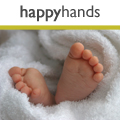Baby Clinic
Baby Care
Avoiding nappy rash
There are all kinds of rashes that might appear around your baby’s bottom, but how can you avoid them?
Not all spots and rashes around your baby’s bottom are nappy rash. Indeed, severe inflamed nappy rash is far less common than milder soreness caused by dampness (or thrush). Nappy rash whether light or more severe is caused when skin is irritated by the ammonia that arises from bacteria in faeces coming into contact with urine. However, if you have a couple of reliable creams or ointments in your changing bag these can usually ward off most uncomfortable skin outbreaks when you also practice good changing habits:
• Cleaning only with water and cotton wool rather than soap or baby wipes in the first six months. If you do need to use cleaning products make sure they are mild ones designed for use with young babies.
• Making sure you change wet nappies regularly.
• Allowing your baby to enjoy a bit of a wriggle in fresh air (with a towel underneath in case of wetting) for 10 or 15 minutes before putting on a new nappy, whenever it’s convenient.
• Only using a thin layer of barrier cream when using disposable nappies otherwise the cream will hamper absorbancy.
• Gently but thoroughly drying around the legs and bottom, which is preferable to using talcum powder.
Barrier creams
In order to keep a baby’s skin protected, it is possible after cleaning to add a thin layer of ‘barrier cream’ to your baby’s bottom, which will act like a light film between skin and ammonia and dampness. These creams need to be light so they allow the skin to breathe whilst being protected.
Choose a barrier cream that is going to be as natural as possible and be kind to your baby’s skin as it will be used regularly.
Read more in our Buyer’s guide to barrier creams.
Nappy Rash treatments
When your baby actually does have a rash it’s good to try to nip any outbreak in the bud. Sometimes changes of diet, teething and other shifts in habits can trigger a rash, so don’t feel you have failed your child – just catch it as early as you can.
If the rash appears as spots that start around the back (anus) and sometimes spread to buttocks and thighs, it might be thrush, for which you may have to get the right cream from your doctor.
Nappy rash itself tends to start with redness around the front (around the genitals) rather than the back, but in severe cases it can spread to the back (around the anus) and the legs. In bad cases it may cause the skin to be raised and broken. With nappy rash you may also notice a smell of ammonia.
Read more in our Buyer’s guide to nappy rash treatments
If creams don’t work
See your GP if a treatment and good nappy habits don’t seem to be working after a couple of days – in a few cases the problem could be a different skin issue such as a form of eczema, or a reaction to something which requires medical attention.
Related Articles
A Great Day Out at The Baby Show, Excel
Preparing Premature Infants for School
BornFree – the natural approach to bottles
Bottle-feeding: keeping it natural
BabyBjörn venture into drinking cups
Buyer's guide to nappy rash treatments
ReadingZone: best new books published in October
Related Products
East Coast, Anna drop side cot
Baroo, cotbed duvet and pillow set
Related Forum Topics
Forums: Baby
Re: Try this perfect family lunch in Hyde Park
Clare, Mother of 2, London
Re: Cranial massage
Clare, Mother of 2, London
Re: does any1 know anything that will help me get my baby into a better sleep routen?
clarejayne, Mother of 1, Nottinghamshire
Re: My daugher's got croup - 8mths
Amelie, Mother of 1
Reproaching a stranger for bad behaviour to their child.
Patricia6
Have Your Say
Be the first person to comment on this article, just post a comment below.





In order to post a comment you need to be a member. Join Now | Sign in